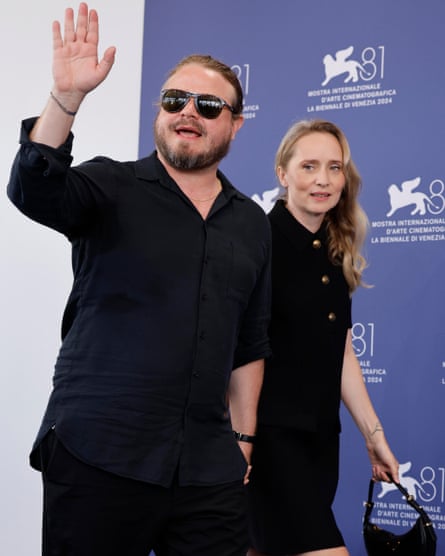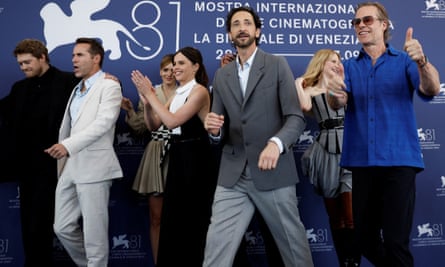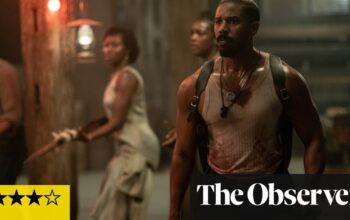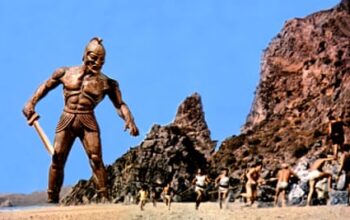How do you properly do justice to the life story of a Hungarian-born Jew who survived the Holocaust and emigrated to the US, where he toiled in poverty and indignity in pursuit of the American dream?
According to the director of the highly anticipated new film The Brutalist the answer is to push back against how long film-makers are given to tell the tale.
Premiering at the Venice film festival on Sunday, the film – which stars Adrien Brody as the Hungarian architect László Tóth – has a running time of 215 minutes and a 15-minute intermission. Movies that go beyond the two-hour mark have increasingly been criticised in recent years as audiences and critics grow weary of sitting in cinema seats for extended periods.
“This was an incredibly difficult film to make,” a teary Brady Corbet said in passionate defence of his film at a festival press conference. “I’m very emotional today because I’ve been working on it for seven years, and it felt urgent every day for the better part of a decade.”

He added: “Because this film does everything we are told that we are not allowed to do. I think it’s quite silly to have a conversation about run time because that’s like criticising a book that has 700 pages instead of 100 pages. I’ve read great novellas and I’ve read longer masterpieces.
“Maybe the next film I make will be 45 minutes, and I should be allowed to do that, everyone should. The idea that we should fit into a box is silly. We should be past that, it’s 2024. As Harmony Korine once said, cinema is stuck in the birth canal. And I agree with him, so we should help it out.”
The film also stars Felicity Jones, Guy Pearce, Joe Alwyn and Isaach de Bankolé, who was applauded at the press conference after saying: “The length of the movie has nothing to do with the story of life. Life can be short or it can be long, it depends how we approach it.”
But long films are a theme of this year’s festival, with many passing the two-hour mark, such as Todd Phillips’s Joker: Folie à Deux (138 minutes), Luca Guadagnino’s Queer (135 minutes), Kevin Costner’s Horizon: An American Saga, chapters 1 and 2 (181 minutes and 190 minutes) and Lav Diaz’s Phantosmia (246 minutes).
The festival director, Alberto Barbera, even reminded attenders to check films’s lengths when planning their schedules.
“One of the somewhat significant transformations the industry is going through concerns the duration of films. Movies used to have this standard running time of between 90 and 120 minutes, but now those movies are the exceptions to a norm,” Barbera told Variety.
“[It’s] due to several factors. One is the impact of TV series. The other is an attempt by the theatrical sector to counteract the competition of streamers by offering viewers more complex, richer, longer experiences at the movie theatre.”
Asked why he decided to make The Brutalist a film instead of a TV series, Corbet, who won awards at Venice in 2015 for his debut film The Childhood of a Leader, added: “In my experience, television is not a writer’s medium but an executive’s medium.”
Brody also spoke of working to “champion” the journey of film-makers who are “trying to make something indelible, with all the obstacles we have in this medium”.

The Oscar winner compared the story of The Brutalist with that of his own mother, a photographer who emigrated to the US during the Hungarian revolution of 1956.
“Much like László she lost her home and pursued a dream of being an artist. I understand a great deal about the repercussions of that on her life and her work as an artist … [The film] is fiction but it feels very real to me,” he said.
Brody has previously defended the runtime of the movie, telling Vanity Fair “it’s hard to tell a lifetime in a film”.
Research by What to Watch suggests the average running time of the most commercially successful films increased from 110 minutes in 1981 to 141 minutes in 2022.
But while nine out of the 10 highest-grossing films of all time clock in at more two hours, with three (Avengers: Endgame, Avatar: The Way of Water and Titanic) lasting more than three hours each, audiences have not always been onboard.
Earlier this year, a market research poll claimed to have established that 92 minutes was the “ideal” movie length for American audiences. Of 2,000 people surveyed, 15% said films of more than 120 minutes were acceptable, while only 2% were happy with a movie longer than 150 minutes.
The issue came to the fore recently after some cinemas interrupted screenings of the 206-minute Martin Scorsese picture Killers of the Flower Moon with an intermission. Scorsese defended his film’s running time, saying: “Give cinema some respect.”
Sarah Atkinson, a professor of screen media at King’s College London, said while intermissions could boost audience levels and concession sales for cinemas, “directors like Scorsese view it as compromising their artistic vision. In contrast, film-makers like Corbet have integrated an interval into the film itself, including a countdown so audiences know when to return to their seats”.
She added: “Films aren’t just getting longer, they’re getting bigger. The Brutalist was shot in 70mm to reflect the widescreen experience of its 1950s temporal setting … This reflects broader trends seen in films like Oppenheimer and Dune: Part Two, which also utilised 70mm and were marketed as must-see theatrical experiences.”
This emphasis on cinematic scale and spectacle, Atkinson said, “is part of a larger effort to preserve film’s status as a unique medium, distinct from home streaming and on a cultural par with theatre”.
Source: theguardian.com


